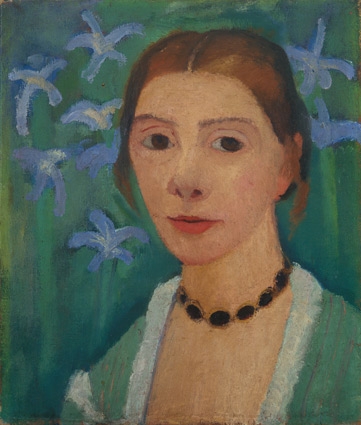In the seventh of his Letters to a Young Poet, written in 1904, Rainer Maria Rilke expresses the hope that ‘someday’ there would emerge ‘women whose name will no longer mean the mere opposite of the male, but something in itself, something that makes one think not of any complement and limit but only of life and reality: a female human being’. In this affectionate biography, Marie Darrieussecq proposes that just such a female human being was not only alive at the time but – in the form of his friend Paula Modersohn-Becker – right in front of the writer’s eyes.
Paula Modersohn-Becker was born into a Germany that Darrieussecq describes as ‘innocent’ – meaning before the wars, and the burden they would impose on twentieth-century German painting – and died in it too, succumbing to a postpartum embolism in 1907. In the intervening 31 years, she produced a body of work that would belatedly secure her status among the most important painters of the short period between the dawn of the century and the prolonged night that descended on Europe shortly afterwards. For many years scandalously little-known outside her native land (where for decades her reputation rested on the popularity of her published letters), Becker’s painting has been the subject of a recent and dramatic reappraisal, including an exhibition at the Musée d’Art Moderne de la Ville de Paris cocurated by Darrieussecq in 2016.
This neglect might partially be attributed to the fact that, beyond certain superficial formal similarities and the coincidence of time and place, Becker sat uncomfortably among the early Expressionists with whom she was typically grouped. This idiosyncrasy is inseparable from her achievements, argues Darrieussecq, as a woman working outside and against a tradition defined by men and, specifically, the male gaze. Becker’s affecting portraits of pubescent girls, mothers and her own body reveal that female human beings are ‘more surprising than the story told by artistic conventions’ (comparisons with the anguished, eroticised or infantilised girls that haunt the paintings of her male peers drives home the point). To succeed as ‘a woman painting women’ required that the artist work outside of male constructions of femininity. In doing so, Becker showed how it is possible for women to ‘invent themselves in a man’s world, by breaking and entering’.
Drawing on the artist’s diary entries, personal correspondence and the evidence offered by her paintings, Darrieussecq’s account of Becker’s life reads more like an elegy for a dead friend than a conventional biography. She quotes liberally from the artist’s witty and winning letters to a close circle of friends including Rilke and the sculptor Clara Westhoff; the artist’s husband, Otto Modersohn, and her mother, Mathilde. The disarmingly simple power of Darrieussecq’s prose – conveyed in a sharp and self-effacing translation by Penny Hueston – seems tailored to accommodate her subject’s voice and to reproduce the emotional directness of her paintings. Indeed, this book seems less interested in elaborating on Becker’s technical achievements or placing her in an art historical lineage than with attempting to evoke the emotional charge of Darrieussecq’s experience of her paintings.
That relationship – like those between painter and model, painting and viewer, biographer and subject – is in the case of Modersohn-Becker premised on intimacy. A portrait of a breastfeeding mother and child is ‘not sentimental, or pious, or erotic’ but instead evokes ‘another sort of sensuality’ and ‘another sort of power’, meaning that which exists among women. Her greatest achievements are in this respect Self-Portrait on her Sixth Wedding Anniversary and Self-Portrait with Amber Necklace (both 1906), in which the artist stands ‘stripped of the masculine gaze’ and comfortable in her body and the regard in which it is held. In becoming the first female painter to portray herself naked for the benefit of other women, Modersohn-Becker introduced to painting a new way of seeing.
If ‘intimacy is’, as the artist wrote in her diaries, ‘the soul of great art’, then it is this quality that Darrieussecq seeks to emulate. Paula – as her biographer comes in the course of her narrative to call her, narrowing the distance from her subject and discarding the surnames that tie her to the ‘mere opposites’ of father and husband – reinvented the way that women are represented. With Being Here Is Everything, Darrieussecq aspires to do the same.
From the April 2018 issue of ArtReview
